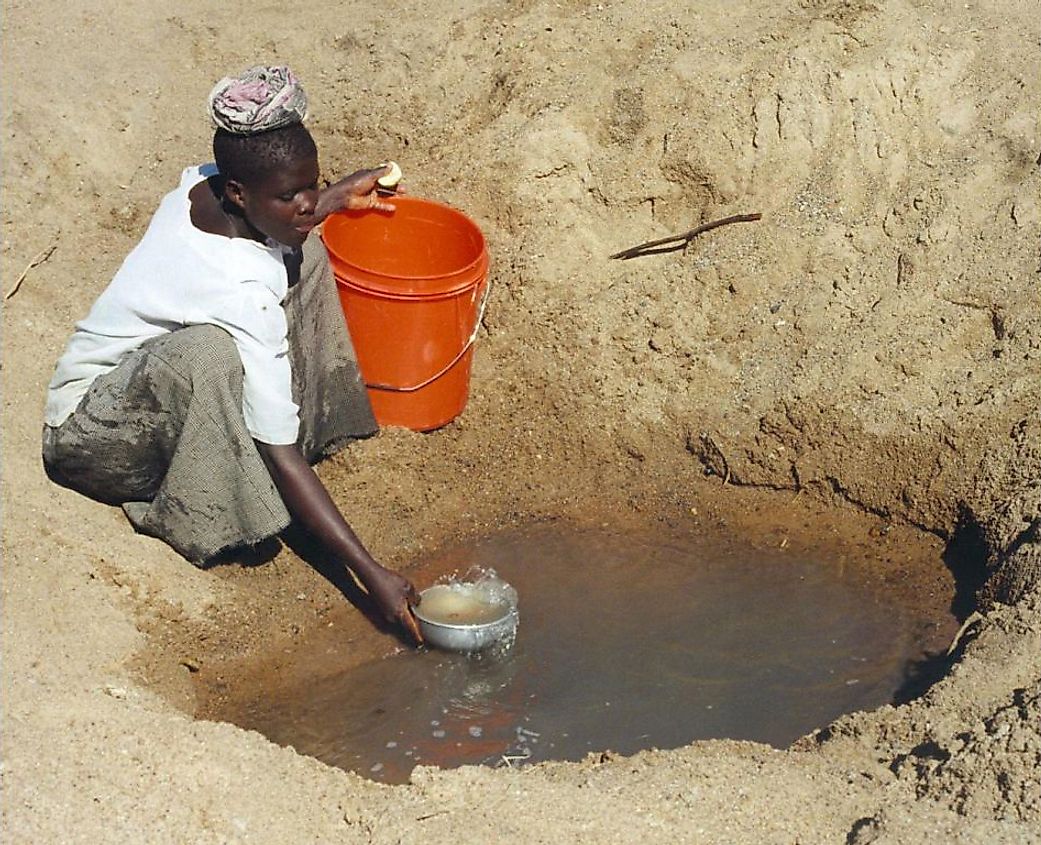Countries With The Worst Water Supply Infrastructure

What is Water Access?
One of the United Nations Millennium Development Goals was to reduce the number of people without access to sustainable and safe drinking water and basic sanitation by 50%. Access is defined by distance and amount of water available. If the water source is less than 0.6 miles away and consistently provides at least 20 liters of water per person in the family, the household is considered to have access to water. Safe drinking water is free of chemicals and microbes that cause disease and is obtained via a household connection, community tap, protected well or spring, and rainwater collection.
Lack of Access to Water
Nearly 1.1 billion people do not have access to safe drinking water around the world, another 663 million cannot access improved water sources. These people are overwhelmingly located throughout sub-Saharan Africa although there are one Pacific island and one Middle Eastern nation on the list of countries with the worst water infrastructures. Papua New Guinea tops that list, only 40% of the population has access to an improved water source. The next six countries are in Africa: Equatorial Guinea (48%), Angola (49%), Chad (51%), Mozambique (51%), Madagascar (52%), and DR Congo (52%). Next is Afghanistan with only 55% of its population having access to improved water sources. This is followed by Tanzania (56%) and Ethiopia (57%).
Consequences of Little or No Access to Water
The consequences of lacking access to clean and safe water, improved water sources, and improved sanitation services are astounding. It affects education, health, hunger, poverty, and the economy. Children seem to bear the burden of inadequate access to water. Of the 1.6 million people who die annually from preventable, diarrhoeal diseases (like cholera), 90% are under five years old. A further 1.5 million people are annually diagnosed with Hepatitis A. This figure is all due to unclean water. In the countries previously listed, an estimated 80% of illness is attributed to poor water and sanitation conditions.
When children are fighting for their lives due to disease and malnutrition (from parasites in water), they are unable to attend school. In fact, a total of 443 million recorded school days is lost every year as a result of water-related illness. This problem is amplified for girls. Girls are more often responsible for collecting water than boys, and when the water source is far away, they miss school to make sure the household has water.
Adults and children who are forced to spend their time collecting water are unable to contribute to the economy by participating in the workforce. Either they do not obtain an education that allows them to go on and contribute to the formal employment sector, or they are consumed with thoughts of collecting water. According to UN estimates, African countries alone lose 40 billion hours annually in efforts to obtain household water.
What is Being Done?
Many non-profits, non-governmental organizations, and government agencies are working together to eliminate this problem across the world, including in the countries mentioned above. The United Nations World Health Organization (WHO) and United Nations Children’s Emergency Fund (UNICEF) have joined forces via the Joint Monitoring Program for Water Supply and Sanitation which is used to measure progress against development goals. WHO also invests in research in order to illustrate the cost effectiveness for governments to invest in providing or improving water and sanitation conditions. They also work with other non-profits, research facilities, and governments to support water access and treatment efforts. UNICEF manages Water, Sanitation, and Hygiene (WASH) teams in order to promote access to clean water, improved toilets, and hygiene practices.
Hope for the Future
Despite all of the negative numbers and consequences, there is hope. The Millennial Goal was met three years ahead of schedule. With a 2015 deadline, the population of people without access to water and improved sanitary facilities was cut in half by 2012. This means that governments and organizations everywhere have used the Millennial Goal indicators as a tool for improving living conditions for citizens. The fact that the goal was reached ahead of schedule indicates that ensuring water access is important to governments and was taken seriously. The countries listed in this article represent a portion of the estimated 11% of the global population that is still without access to water.
Countries With The Worst Water Supply Infrastructure
| Rank | Country | % of Population With Access To Improved Water Sources |
|---|---|---|
| 1 | Papua New Guinea | 40% |
| 2 | Equatorial Guinea | 48% |
| 3 | Angola | 49% |
| 4 | Chad | 51% |
| 5 | Mozambique | 51% |
| 6 | Madagascar | 52% |
| 7 | DR Congo | 52% |
| 8 | Afghanistan | 55% |
| 9 | Tanzania | 56% |
| 10 | Ethiopia | 57% |











